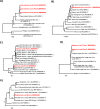Establishment of Culex modestus in Belgium and a Glance into the Virome of Belgian Mosquito Species
- PMID: 33883261
- PMCID: PMC8546715
- DOI: 10.1128/mSphere.01229-20
Establishment of Culex modestus in Belgium and a Glance into the Virome of Belgian Mosquito Species
Abstract
Culex modestus mosquitoes are considered potential transmission vectors of West Nile virus and Usutu virus. Their presence has been reported across several European countries, including one larva detected in Belgium in 2018. In this study, mosquitoes were collected in the city of Leuven and surrounding areas in the summers of 2019 and 2020. Species identification was performed based on morphological features and partial sequences of the mitochondrial cytochrome oxidase subunit I (COI) gene. The 107 mosquitoes collected in 2019 belonged to eight mosquito species, Culex pipiens (24.3%), Cx. modestus (48.6%), Cx. torrentium (0.9%), Culiseta annulata (0.9%), Culiseta morsitans (0.9%), Aedes sticticus (14.0%), Aedes cinereus (9.3%), and Anopheles plumbeus (0.9%), suggesting the presence of an established Cx. modestus population in Belgium. The collection of Cx. modestus mosquitoes at the same locations in 2020 confirmed their establishment in the region. Haplotype network analysis of the COI sequences for Cx. modestus showed that the Belgian population is rather diverse, suggesting that it may have been established in Belgium for some time. The Belgian Cx. modestus population was most closely related to populations from the United Kingdom and Germany. Characterization of the virome of the collected mosquitoes resulted in the identification of at least 33 eukaryotic viral species. Nine (nearly) complete genomes belonging to 6 viral species were identified, all of which were closely related to known viruses. In conclusion, here, we report the presence of Cx. modestus in the surrounding areas of Leuven, Belgium. As this species is considered to be a vector of several arboviruses, the implementation of vector surveillance programs to monitor this species is recommended.IMPORTANCECulex modestus mosquitoes are considered to be a potential "bridge" vector, being able to transmit pathogens between birds as well as from birds to mammals, including humans. In Belgium, this mosquito species was considered absent until the finding of one larva in 2018 and subsequent evidence of a large population in 2019 to 2020 described here. We collected mosquitoes in the summers of 2019 and 2020 in the city of Leuven and surrounding areas. The mosquito species was identified by morphological and molecular methods, demonstrating the presence of Cx. modestus in this region. The ability of mosquitoes to transmit pathogens can depend on several factors, one of them being their natural virus composition. Therefore, we identified the mosquito-specific viruses harbored by Belgian mosquitoes. As Cx. modestus is able to transmit viruses such as West Nile virus and Usutu virus, the establishment of this mosquito species may increase the risk of virus transmission in the region. It is thus advisable to implement mosquito surveillance programs to monitor this species.
Keywords: Belgium; Culex modestus; haplotype; mosquito; virome.
Copyright © 2021 Wang et al.
Figures






References
-
- Ficalbi E. 1889. Zanzara di colorito modesto. Boll Soc Entomol Ital 1:93–94.
-
- European Centre for Disease Prevention and Control, European Food Safety Authority. 2020. Culex modestus—current known distribution: May 2020. European Centre for Disease Prevention and Control, Stockholm, Sweden.
-
- Hernández‐Triana LM, Brugman VA, Pramual P, Barrero E, Nikolova NI, Ruiz‐Arrondo I, Kaiser A, Krüger A, Lumley S, Osório HC, Ignjatović‐Ćupina A, Petrić D, Laure Setier‐Rio M, Bødker R, Johnson N. 2020. Genetic diversity and population structure of Culex modestus across Europe: does recent appearance in the United Kingdom reveal a tendency for geographical spread? Med Vet Entomol 34:86–96. doi:10.1111/mve.12412. - DOI - PubMed
-
- Lindström A, Lilja T. 2018. First finding of the West Nile virus vector Culex modestus Ficalbi 1889 (Diptera; Culicidae) in Sweden. J Eur Mosq Control Assoc 36:1–2.
Publication types
MeSH terms
Supplementary concepts
LinkOut - more resources
Full Text Sources
Other Literature Sources
Research Materials

